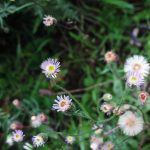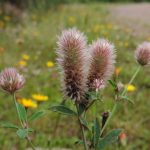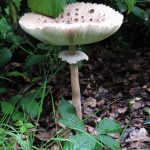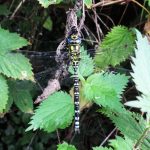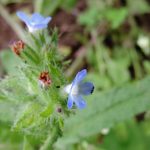Mud and puddles greeted the 17 members who met for a walk, led by Ken and Sarah White, through the northernmost edge of the Bramshill Forest plantations and along the flood meadows of the Blackwater River. The recent rains had refreshed a lot of the vegetation such that many species were found bearing flowers. The walk started on the south side of the river on the acid Quaternary sands & gravel, a site of former gravel extraction which ended about 25 years ago. Mature Scots Pine along the boundary have given way to new successions of pioneering plant communities which raced to fill the formerly bare ground and lake edges. Some conifer planting occurred, though much of the regrowth seems to have been from wind-blown seed. Ling, Bell Heather and Gorse dominate the ground, but in between these, patches of Dwarf Gorse Ulex minor in full flower contrasted beautifully with the mixed pinks of the heathers. The rides and pathways offered herbaceous interest in the way of Corn Mint Mentha arvensis, Brooklime Veronica beccabunga, three of the plantains including Plantago coronopus, Common Centaury Centaurium erythraea, Blue Fleabane Erigeron acris, Hare’s-foot Clover Trifolium arvense and Slender Rush Juncus tenuis. Large swathes of Common Fleabane Pulicaria dysenterica kept the yellow-flower theme going. Forestry plantings included not only 6 species of conifer but also some Black Locust Robinia pseudoacacia and Southern Beech Nothofagus sp. Various fungi were breaking through the ground but the best by far was a textbook Parasol Mushroom Macrolepiota procera. The final calcifuge was Alder Buckthorn Frangula alnus, now bearing some black fruits.
As we approached the footbridge back over the river, flowering Common Hemp-nettle Galeopsis tetrahit attracted a lot of attention, as did the Greater Celandine Chelidonium majus and a white flowering form of Selfheal Prunella vulgaris, but for the first members on the bridge a fast disappearing Kingfisher made a quiet approach worthwhile. Orange Balsam Impatiens capensis studded the riverbank water’s edge, and surprising numbers of Banded Demoiselles Calopteryx splendens flitted up and down the gently flowing Blackwater River. A superb Southern Hawker Aeshna cyanea was photographed not far from the river. We then passed through numerous horse-grazed meadows, and the damp London Clay soils here yielded a continuous margin of willows and Alder; other marginal plants included Gypsywort Lycopus europaeus and Himalayan Balsam Impatiens glandulifera. The clay fields to the north of the river are mixed with sands from the Tertiary capping on Farley Hill which has resulted in a rich sandy loam. The first field was a dense sward of flowering Italian Rye-grass Lolium multiflorum, previously cut for silage earlier in the season, but growing back strongly; a specimen of Dwarf Mallow Malva neglecta was growing on the footpath edge. The next three fields had very recently cut and harvested Lucerne [Alfalfa] Medicago sativa ssp. sativa which had attracted the attention of at least 11 Red Kites and an amazing flock of 60 Pied Wagtails, a mix of adults and juveniles. The Lucerne field margin along the footpath had been missed by the cutters, and was a delight to investigate: Bugloss Anchusa arvensis in full flower alongside Field Pansy Viola arvensis and the odd Common Poppy Papaver rhoeas. The ancient ford crossing the Blackwater – used by the Roman Road linking London to Silchester – was a daunting prospect to wade through at 2.5 feet deep, so the footbridge just a bit further on was much appreciated and provided the walk’s second Kingfisher. The group tail-enders had to make do with a fine stand of Common Club-rush Schoenoplectus lacustris, and the wailing of two young Buzzards overhead learning to fly with their parents in what had become a bright and breezy day. After the walk, most of the party stayed on for lunch at The Bull at Riseley.
Report by Ken White
Pictures by Rob Stallard
| English Name | Scientific Name | Gridref |
| Plants | ||
| Marsh Cudweed | Gnaphalium uliginosum | |
| Selfheal (white form) * | Prunella vulgaris | |
| Common Hemp-nettle | Galeopsis tetrahit | |
| Blue Fleabane * | Erigeron acer | |
| Greater Celandine | Chelidonium majus | |
| Dwarf Mallow * | Malva neglecta | SU 7528 6354 |
| Common Stork’s-bill | Erodium cicutarium | |
| Italian Rye-grass | Lolium multiflorum | |
| Field Pansy | Viola arvensis | |
| Bugloss * | Anchusa arvensis | SU 7486 6353 |
| Lucerne [Alfalfa] | Medicago sativa ssp. sativa | |
| Common Poppy | Papaver rhoeas | |
| Orange Balsam * | Impatiens capensis | |
| Branched Bur-reed | Sparganium erectum | |
| Himalayan Balsam | Impatiens glandulifera | |
| Gypsywort * | Lycopus europaeus | |
| Common Centaury | Centaurium erythraea | |
| Hare’s-foot Clover | Trifolium arvense | |
| Scarlet Pimpernel | Anagallis arvensis | |
| Common Toadflax | Linaria vulgaris | |
| Alder Buckthorn * | Frangula alnus | |
| Field Mint * | Mentha arvensis | |
| Water Mint * | Mentha aquatica | |
| Brooklime | Veronica beccabunga | |
| Upright Hedge-parsley | Torilis japonica | |
| Dwarf Gorse | Ulex minor | |
| Common Gorse | Ulex europaeus | |
| Southern Beech | Nothofagus sp. | |
| Scots Pine | Pinus sylvestris | |
| Black Pine | Pinus nigra | |
| Hemlock | Tsuga heterophylla | |
| Douglas Fir | Pseudotsuga menziesii | |
| Western Red Cedar | Thuja plicata | |
| Norway Spruce | Picea abies | |
| Fir sp. | Abies sp. | |
| Larch | Larix decidua | |
| Black Locust | Robinia pseudoacacia | |
| Wild Carrot | Daucus carota | |
| Bell Heather | Erica cinerea | |
| Cross-leaved Heath | Erica tetralix | |
| Ling [including a white form] | Calluna vulgaris | |
| Blackberry | Rubus fruticosus | |
| Greater Plantain | Plantago major | |
| Ribwort Plantain | Plantago lanceolata | |
| Buck’s-horn Plantain | Plantago coronopus | |
| Common Spotted-orchid | Dactylrhoriza | |
| Club rush * | Schoenoplectus lacustris | |
| Tufted Vetch | Vicia cracca | |
| Common Fleabane | Pulicaria dysenterica | |
| Purple Moor-grass | Molinia caerulea | |
| Slender Rush | Juncus tenuis | |
| Fungi | ||
| Parasol Mushroom | Macrolepiota procera | |
| Invertebrates | ||
| Southern Hawker | Aeshna cyanea | |
| Brown Hawker | Aeshna grandis | |
| Banded Demoiselle | Calopteryx splendens | |
| Speckled Wood | Pararge aegeria | |
| Birds | |
| Cormorant | |
| Canada Goose | |
| Mallard | |
| Pheasant | |
| Coot | |
| Buzzard | 4 with fledged young |
| Red Kite | 11 |
| Kestrel | |
| Kingfisher | 2 |
| Great Spotted Woodpecker | |
| Woodpigeon | |
| Collared Dove | |
| Stock Dove | |
| Swallow | |
| Starling | |
| Bullfinch | |
| Robin | Autumn song |
| Pied Wagtail | 60, adults and juveniles |
| Carrion Crow | |
| Jay | |
| Raven | 2 |
List by Ken and Sarah White

